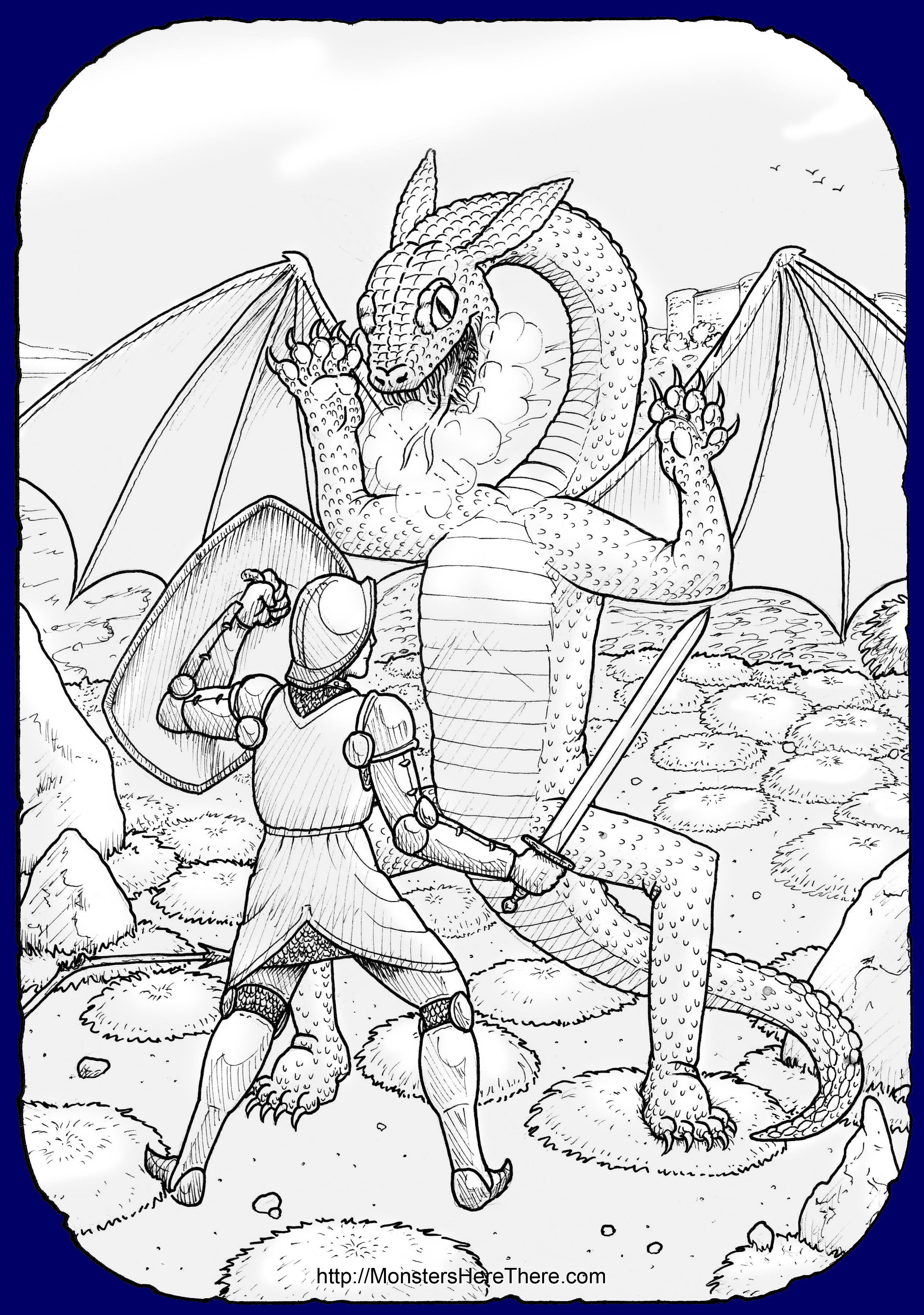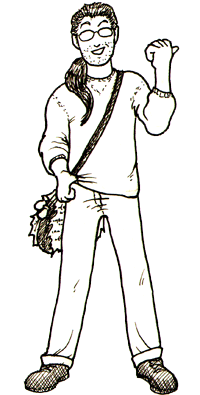| Area(s) Reported: Rhodes; Greece; Europe
Date(s) Reported: 1323~1346 CE
Sometime between 1323 to 1346CE, the island of Rhodes became the home of a dragon, much to the dismay of the people living there! The dragon was as big as "a medium-sized horse," had a snake-like head with a mouthful of sharp teeth, and two hard protuberances that looked like "the ears of a mule." Its skin was scaly and hard, it had four clawed paws, a tail like a lizard's, and a pair of wings on its back which, when beating, allowed the beast to run as fast as a horse. When rushing about this way, the beast made an unmistakable hissing noise that filled those who heard it with terror, for not only did the monster attack and kill animals and men directly, but the foul creature also had a breath that was so poisonous that simply approaching the cave it took up as its home could kill the curious. Luckily, the island of Rhodes was also the home to the Order of Saint John of Jerusalem, a stout group of Catholic knights, who did not ignore the threat this hideous beast posed to their island home... until several knights had already been killed in their attempts to battle the monster. After this, the Grand Master of the order decreed that no more of the knights were to approach the cave the dragon was settled in, nor should they engage in battle with it, under threat of severe penalties. But one knight could not turn a blind eye to the matter; nor was he stupid enough to approach a possible battle with the monster unprepared. Dieudonné de Gozon, on some premise, excused himself from the island for a time to visit the castle of his older brother in France. What the Grand Master and other knights didn't know was that Gozon had a mock-up of the dragon created at his brother's castle, which was used to train his horse and two powerful dogs to attack the great beast as a team with him. Upon his return to Rhodes, he secretly deposited his weapons and animals, along with some of his servants, at a church near the dragon's lair, and returned to the order with just one servant... one who did not know about his secret plan. On the day of the battle, Gozon told the servants at the church to watch from a distance; if he was killed they should flee, but if he was victorious, they should be ready to assist him... for he didn't expect to leave the fight in good shape! Gozon approached the dragon's cave on horseback, accompanied by his dogs. The dragon did not make them wait long. 
Riding hard, Gozon leveled his spear at the beast, only to have the weapon shatter against the creature's rock-like scales. The dogs attacked the monster from all sides, keeping it guessing... and one of them got a critical bite in on the dragon's genitals [Ouch!]. This all gave Gozon time to retrieve the head of his spear and approach the beast on foot, and (despite what I drew above) Gozon was able to plunge the spear head into the monster's throat, where the skin was stretched tight and much softer than the scales protecting the majority of the beast. Both Gozon and the dragon fell at the same time; the dragon dying, and Gozon suffering from the effort of the fight, the poisonous air around the monster, and the loss of blood from many wounds. The servants he had stationed nearby quickly rescued him, and news of the battle spread as he was being nursed back to health. Gozon was in the Grand Master's ire for awhile -- for defying orders -- but that seems to have blown over by 1346CE, when the previous Grand Master stepped down and Gozon became the new Grand Master of the Order of St. John. It's likely Gozon's defeat of the dragon was a large part of the reason he got the job; and, or so its been told, after Gozon died in 1353CE, his tombstone was embellished with, among other distinctions, the term "Draconis extinctor"... "Dragon Slayer." It is also said that Gozon's family still had in their possession around 1600CE a fabulous stone that had been found within the body of the dragon. The stone was the size of an olive, "shining like jasper, painted in various colors," and when dropped into water caused the fluid to boil, after which the water could cure all kinds of poison. Another knight had reported seeing water made from the stone cause a poisoned man to vomit up a foot long snake, thus completely curing him! Tale or Legend? The earliest accounting of Gozon's battle that anyone seems able to find is in a book called Histoire des chevaliers de l'Ordre de S. Jean de Jérusalem -- which translates as "History of the Knights of the Order of St. John of Jerusalem" -- and which was written by Pierre de Boissat and published in 1629. Boissat [1603-1662] was a soldier, writer, poet, and most importantly, a translator. Boissat's book on the history of the knights of Rhodes is largely a translation of an earlier Italian work by a man named Jaques Bosio, who was asked by the Grand Master of the order in 1589 to finish a book on the history of the knights started by an even earlier writer and soldier, Commander John Anthony Fossan. There's just no more known history. No one seems to have a copy of Bosio's earlier book, or Fossan's even earlier book... so we have just Boissat's accounting of the event to work with. Which means all that is currently known about Gozon's battle comes from a book written around three-hundred years after the clash occurred! Makes it hard to double-check facts, I'll tell you what! Boissat's account of the matter was passed down by historians without being questioned for centuries; believe it or not, it wasn't until around 1856 that someone took any sort of serious affront with the story of Gozon fighting a dragon. In an article in the French journal L'Athenaeum Francais, an author named Lud. Lalanne proclaimed the story to be false; but the evidence for it being false came down to just two things. First, Lalanne pointed out that several histories relating tales of the Grand Masters on Rhodes left the story of the dragon out of their tales of Gozon's activities; so Lalanne assumed if the dragon wasn't mentioned by everyone, there must not have been a dragon. The second 'evidence' was, essentially, "c'mon, guys, dragons don't exist"... Lalanne considered his/her own belief in the non-existence of dragons to be proof the dragon hadn't been there! Unfortunately for Lalanne's argument, a non-belief in dragons would also explain why some historians might not have included the story in their accounts, even if a dragon had actually been there; so neither argument proved the dragon didn't exist. There was, actually, one more piece of evidence that was reported to possibly confirm the existence of the dragon of Rhodes. In 1686 -- sixty-four years after Boissat wrote about the battle -- an author named Jean de Thevenot published the first of multiple volumes recounting his various trips through interesting places in Europe; and in this first volume, he talks about his visit to the both the island of Rhodes, and the city of the same name on the island... where he saw the dragon's head. Thevenot briefly states that the head used to hang over a city gate that faced the dragon's former lair, but had at some time in the past been moved to hang above the gate that faced the harbor. He then describes the head itself, as far as it looked to him at the time: "...the Dragons Head, which is much Thicker, Broader, and Longer than a Horses Head, the Jaws of it are slit up to the Ears, with very great Teeth on each side; it is flat above, hath Eyes somewhat bigger than those of a Horse, the hole of the Nostril full round, and the Skin of a greyish White Colour (perhaps because of the Dust that sticks to it) and appears to be very hard." This description has since been belittled by various people who don't believe in dragons -- and who don't reprint the quote above for their readers -- as describing either a large crocodile's head or a hippopotamus' head, presumably placed above the gates for gullible tourists. Whether or not Thevenot's description matches those guesses, I will agree on two things. The head Thevenot describes was probably for the benefit of tourists, who would ask about it and then hear the tale of Gozon's battle as their reward. I'd also wager that the head Thevenot saw wasn't the actual dragon's head, because the actual head would have been over three hundred years old by then... and I'd fear what that thing would both look and smell like! | |








